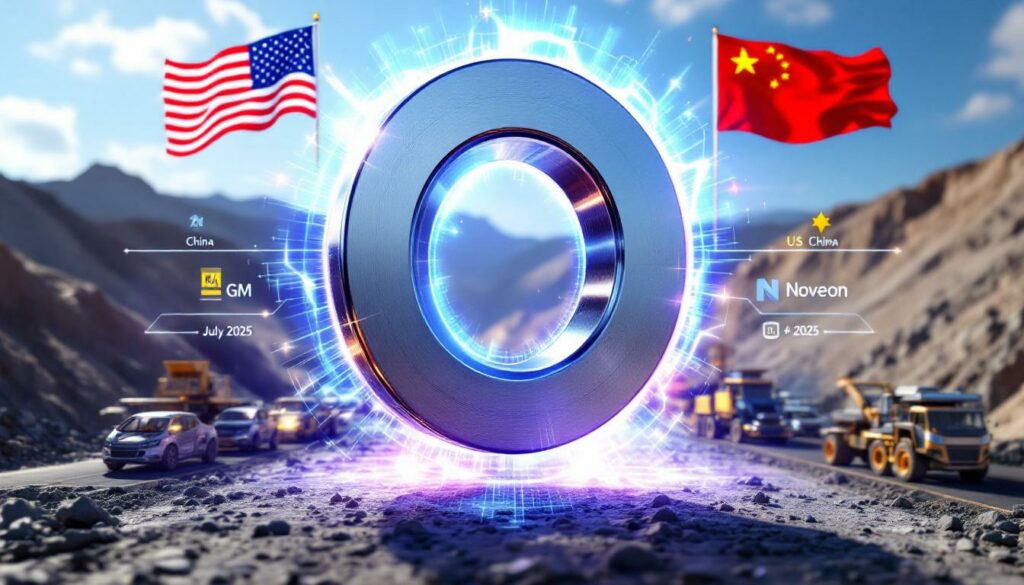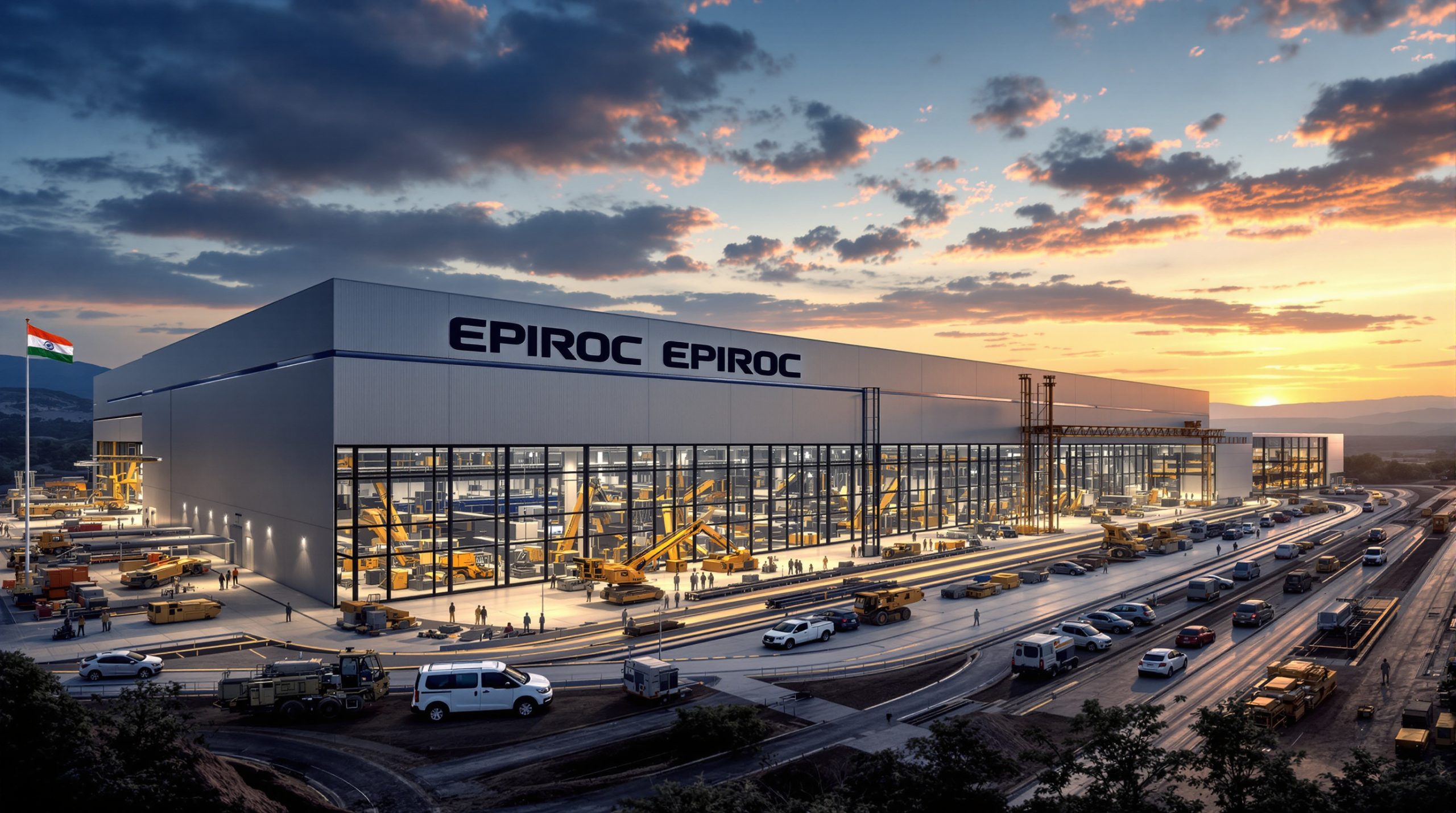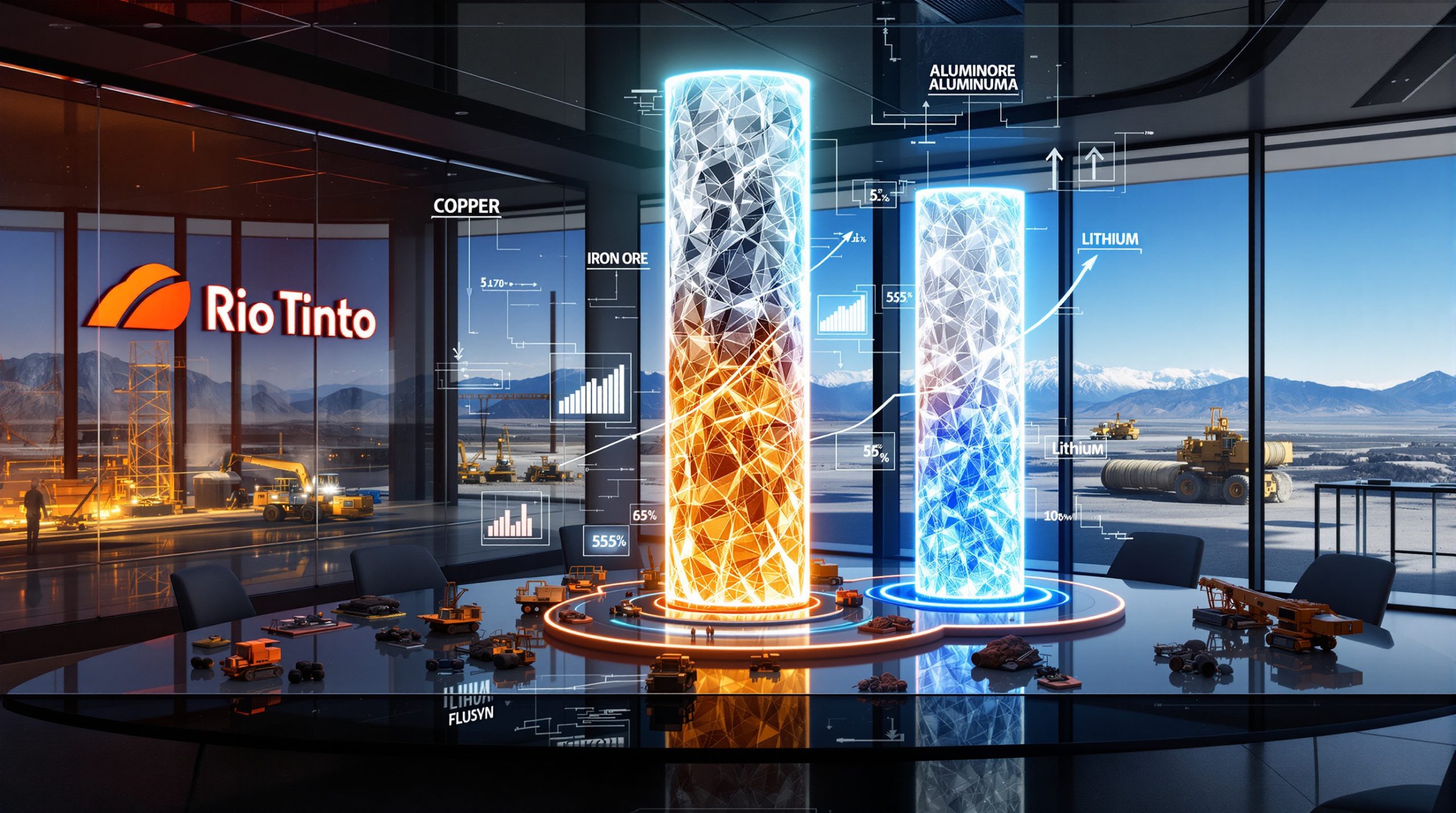GM and Noveon Forge Historic US Rare Earth Magnet Partnership
In a strategic move that signals a significant shift in automotive supply chains, General Motors has entered into a multi-year partnership with Noveon Magnetics for the supply of rare earth magnets. This landmark GM and Noveon rare earth magnet deal, which began deliveries in July 2025, represents a crucial step toward reducing dependence on Chinese rare earth processing and securing domestic production of critical components for America's automotive industry.
The Strategic Significance of GM's Rare Earth Partnership
The agreement between GM and Noveon Magnetics carries implications far beyond a simple supply contract. As China currently controls more than 90% of global rare earth processing capacity, this partnership represents a deliberate effort to diversify supply chains and reduce vulnerability to US‑China trade tensions.
"This partnership represents a critical step in building resilience in our supply chain for these essential components," said a GM spokesperson. "By working with domestic suppliers, we're not only securing our production needs but also supporting American manufacturing capabilities."
The timing of this deal is particularly significant, coming just months after China imposed new export licensing rules in April 2025 that have tightened supply to Western manufacturers across multiple industries—from automotive and defense to consumer electronics.
Ford executives have already reported that these restrictions caused production disruptions due to a pinched supply of rare earth magnets. GM's proactive approach through this partnership may help insulate the automaker from similar challenges.
What Are Rare Earth Magnets and Why Are They Critical for Automakers?
Understanding Neodymium-Iron-Boron (NdFeB) Magnets
Neodymium-Iron-Boron (NdFeB) magnets represent the pinnacle of commercial magnetic technology. These sintered magnets are currently the strongest permanent magnets commercially available, producing magnetic fields up to 1.4 teslas—making them significantly more powerful than traditional ferrite or alnico magnets.
This extraordinary strength-to-weight ratio makes NdFeB magnets indispensable in modern automotive applications, particularly in:
- Electric vehicle traction motors
- Power steering systems
- Sensors and actuators
- Starter motors and generators
- Speakers and audio systems
A typical electric vehicle may contain anywhere from 1-2 kg of rare earth materials, primarily in the form of these high-performance magnets that enable the efficiency and power density required for modern electric drivetrains.
The Critical Role of Rare Earth Elements in Modern Manufacturing
The 17 elements collectively known as rare earths possess unique electromagnetic properties that make them irreplaceable in many high-technology applications. Despite their name, most rare earth elements are relatively abundant in the Earth's crust—the challenge lies in finding economically viable concentrations and the environmentally complex extraction and refining processes.
Automakers, particularly those focused on electric vehicles, have become among the largest industrial consumers of rare earth materials. The International Energy Agency projects that demand for rare earths in EV motors could increase by 350-700% by 2030, creating potential supply bottlenecks without diversified sources.
Industry Context: While rare earths are used in numerous applications, the automotive sector's growing dependence on these materials for electrification strategies makes supply chain security a competitive advantage in the rapidly evolving EV market.
How China's Export Controls Are Disrupting Global Supply Chains
China's Dominance in the Rare Earth Market
China's strategic position in the rare earth industry didn't happen by accident. Beginning in the 1980s, China implemented a deliberate strategy to develop its rare earth resources, investing in mining, processing, and manufacturing capabilities while much of the Western world outsourced these activities.
By the early 2000s, China had effectively consolidated control over the global rare earth supply chain, leveraging several advantages:
- Rich geological deposits, particularly in Inner Mongolia
- Lower environmental regulatory hurdles (historically)
- Comprehensive integration from mining to magnet manufacturing
- Substantial government investment and subsidies
- Technical expertise development through decades of focus
This dominance gives China significant leverage in international trade relationships, with rare earths potentially serving as bargaining chips in broader geopolitical and economic negotiations.
Recent Export Restrictions and Their Impact
The new export licensing rules implemented by China in April 2025 represent the latest in a series of measures that have progressively tightened control over rare earth exports. These regulations require exporters to obtain special permits and provide detailed information about foreign customers and end uses.
The impact on Western manufacturers has been immediate and substantial:
- Production delays for high-tech manufacturers
- Increased costs as companies scramble for alternative sources
- Accelerated efforts to develop non-Chinese supply chains
- Strategic stockpiling by governments and large corporations
- Renewed interest in rare earth recycling technologies
Ford's reported production disruptions highlight the vulnerability of even the largest global manufacturers to these supply chain pressures, underscoring the strategic value of GM's partnership with Noveon.
Why Is Noveon's US-Based Production Significant?
America's Only Commercial NdFeB Magnet Manufacturer
Noveon's unique position as the only operational manufacturer of sintered NdFeB magnets in the United States makes this partnership particularly noteworthy. While several companies are working to establish domestic rare earth processing capabilities, Noveon has successfully scaled commercial production of finished magnets—representing a crucial link in rebuilding a complete domestic supply chain.
The company's manufacturing capabilities include:
- Full-scale production of sintered NdFeB magnets
- Advanced quality control systems meeting automotive specifications
- Custom formulations optimized for specific applications
- Surface treatment and coating capabilities
- Precision machining for complex geometries
This technical expertise is particularly valuable as the skills and knowledge required for high-performance magnet production have largely migrated to Asia over the past three decades.
Strategic Advantages of Domestic Production
The benefits of securing a domestic magnet supply extend beyond simply avoiding Chinese export restrictions:
-
Supply Chain Transparency: Direct relationships with domestic suppliers allow for greater visibility and control over material sourcing and manufacturing processes.
-
Reduced Transportation Costs and Carbon Footprint: Shorter supply chains mean fewer emissions from international shipping and reduced vulnerability to logistics disruptions.
-
Quality Control and Intellectual Property Protection: Working with domestic partners facilitates closer collaboration on quality standards and protects proprietary designs and specifications.
-
National Security Alignment: Rare earth magnets are critical components in defence materials strategy, making domestic production capabilities a matter of national security.
-
Just-in-Time Manufacturing Support: Proximity allows for more responsive production adjustments and reduced inventory carrying costs.
What Does the GM-Noveon Deal Include?
Terms of the Multi-Year Agreement
While the full financial details of the agreement remain confidential, public statements confirm that the supply timeline began in July 2025, with magnets designated primarily for components in GM's full-size SUVs and trucks—including popular models like the Chevrolet Silverado, GMC Sierra, Cadillac Escalade, and GMC Yukon.
The partnership likely includes provisions for:
- Guaranteed minimum purchase volumes
- Quality certification processes
- Technical collaboration on magnetic performance specifications
- Potential expansion pathways as production scales
- Contingency planning for supply disruptions
Industry analysts estimate that securing domestic magnet supply for GM's full-size vehicle lineup could represent hundreds of thousands of units annually, providing Noveon with the stable demand needed to justify further capacity expansions.
Implementation and Integration Strategy
The integration of Noveon's magnets into GM's vehicle components will likely follow a phased approach, beginning with less critical applications before expanding to powertrain and safety systems. This gradual implementation allows for thorough validation of performance and reliability while minimizing production disruption risks.
Key application areas may include:
- Electric power steering systems
- Starter motors and alternators
- Seat adjustment motors and actuators
- HVAC blower motors
- Sensors and position detectors
- Sound system components
For each application, engineers must validate that the domestically produced magnets meet or exceed the performance specifications of previously sourced components, particularly regarding thermal stability, corrosion resistance, and long-term magnetic performance.
How Does This Deal Fit into Broader Industry Trends?
Automotive Industry's Rare Earth Dependency
The automotive sector's reliance on rare earth magnets has grown steadily as vehicles incorporate more electronic systems and electrified powertrains. This trend accelerates dramatically with the transition to electric vehicles, where rare earth magnets play a crucial role in motor efficiency and power density.
| Vehicle Type | Typical Rare Earth Content |
|---|---|
| Conventional ICE | 0.5-1 kg |
| Hybrid Electric | 1-2 kg |
| Battery Electric | 2-5 kg |
| Heavy-Duty EV | 5-10+ kg |
Ford's reported production disruptions due to magnet supply constraints demonstrate that even traditional vehicle production—not just EVs—faces vulnerability to rare earth supply issues. As the industry continues its electrification journey, securing stable magnet supply becomes increasingly critical to manufacturing continuity.
The Race for Supply Chain Security
GM's partnership with Noveon represents one facet of a broader industry-wide effort to secure critical minerals transition supply chains:
-
Government Initiatives: The U.S. Department of Energy has allocated over $140 million to rare earth and critical mineral projects through various programs since 2021.
-
Mining Revitalization: Companies like MP Materials are working to restore domestic rare earth mining and processing capabilities at sites like Mountain Pass in California.
-
Alternative Technologies: Some manufacturers are investing in magnet designs that reduce or eliminate heavy rare earth elements like dysprosium and terbium, which face the most severe supply constraints.
-
Recycling Development: Emerging technologies for recovering rare earth elements from end-of-life products and manufacturing waste are gaining traction as potential supplementary supply sources.
-
International Partnerships: Strategic alliances with allies like Australia, Canada, and European nations are forming to create "friendly" supply networks outside of Chinese control.
Market Perspective: While China will likely maintain its dominant position in rare earth processing for the foreseeable future, these diversification efforts aim to create enough alternative capacity to reduce leverage and ensure continuous supply for critical industries.
What Are the Market Implications of Domestic Rare Earth Production?
Economic Impact of Reshoring Critical Industries
The development of domestic rare earth magnet production represents more than just supply chain security—it creates substantial economic opportunities through:
-
High-Skilled Manufacturing Jobs: Magnet production requires specialized technical knowledge, creating well-paying positions in materials science, engineering, and advanced manufacturing.
-
Technology Development: Proximity between manufacturers and end-users accelerates innovation and problem-solving, potentially leading to performance improvements and new applications.
-
Industrial Ecosystem Growth: A successful magnet producer attracts related businesses, from specialized machine shops to materials suppliers, creating a manufacturing cluster effect.
-
Educational Investment: The need for qualified workers drives partnerships with educational institutions, supporting STEM education and workforce development programs.
The multiplier effect of reshoring advanced manufacturing extends beyond direct employment at facilities like Noveon's, creating economic activity throughout the supply chain and supporting communities where these facilities operate.
Price and Availability Projections
Domestic production of rare earth magnets faces inherent cost challenges compared to Chinese alternatives due to:
- Higher labor costs
- Stricter environmental regulations
- Smaller scale operations initially
- Higher capital costs for new facilities
- Less developed supplier networks
However, several factors may offset these disadvantages over time:
-
Supply Risk Premium: Manufacturers may accept modest price premiums for supply security and reduced disruption risk.
-
Automation and Process Innovation: New facilities can implement advanced mining industry innovation techniques that reduce labor costs.
-
Reduction in Logistics Costs: Shorter supply chains eliminate international shipping expenses and reduce inventory carrying costs.
-
Potential Policy Support: Government incentives, tariff considerations, and strategic priorities may provide financial support mechanisms.
-
Increasing Chinese Production Costs: Rising wages and strengthening environmental standards in China are gradually reducing the cost differential.
As domestic production scales and matures, the price gap with imported magnets is likely to narrow, particularly when factoring in the full cost of supply disruption risks.
What Challenges Remain for US Rare Earth Independence?
Technical and Manufacturing Hurdles
Despite progress in rebuilding domestic capabilities, significant challenges remain in establishing a complete and competitive U.S. rare earth supply chain:
-
Scale Limitations: Current domestic production represents only a fraction of U.S. demand, requiring substantial capacity expansion.
-
Processing Expertise Gap: Decades of offshoring have eroded technical knowledge in critical separation and processing steps.
-
Material Purity Requirements: High-performance magnets require ultra-pure rare earth oxides, demanding sophisticated processing capabilities.
-
Workforce Development Needs: Specialized training programs must be expanded to support industry growth.
-
Equipment and Tooling Supply: Much of the specialized equipment for rare earth processing is now manufactured in China, creating another dependency layer.
These challenges require coordinated efforts between industry, government, and educational institutions to overcome, likely necessitating a sustained multi-year investment strategy.
Economic Viability Concerns
The long-term sustainability of domestic rare earth production depends on addressing fundamental economic questions:
-
Investment Recovery Timeframes: The capital-intensive nature of rare earth processing requires patient capital with longer return horizons than typical in U.S. markets.
-
Competition with Subsidized Production: Chinese rare earth industries benefit from various forms of government support that domestic producers must compete against.
-
Demand Certainty: Manufacturers need sufficient guaranteed demand to justify major capacity investments, creating a chicken-and-egg problem with customers who need proof of capability before committing.
-
Environmental Compliance Costs: Responsible processing practices necessary to meet U.S. environmental standards add costs not always faced by international competitors.
-
Vertical Integration Challenges: A fully domestic supply chain requires coordination across mining, separation, metal production, alloy creation, and magnet manufacturing—each with its own economic challenges.
How Might the Rare Earth Supply Chain Evolve?
Future Production Capacity Projections
The global rare earth landscape is evolving rapidly, with several trends likely to reshape supply patterns over the coming decade:
-
Diversified Mining Operations: New mines in Australia, Canada, and Africa are expanding the geographic distribution of rare earth resources.
-
Processing Technology Advancements: Novel extraction and separation techniques may reduce costs and environmental impacts of rare earth processing.
-
Chinese Consolidation: China continues to consolidate its domestic rare earth industry under larger state-influenced entities, potentially increasing pricing power.
-
Recycling Contribution: End-of-life recycling could provide 5-10% of rare earth demand by 2030, reducing pressure on primary mining.
-
Substitution Effects: Research into alternative materials may reduce dependence on specific rare earth elements for certain applications.
While China will likely maintain its dominant position, the combined effect of these developments should gradually increase the share of non-Chinese production in global markets.
Potential for Additional Domestic Partnerships
The GM-Noveon deal may represent the beginning of a broader trend of strategic partnerships between U.S. manufacturers and domestic material suppliers. Several factors could accelerate this movement:
-
Success Breeding Success: Demonstrated viability of the GM-Noveon model would reduce perceived risk for other potential partnerships.
-
Policy Incentives: Tax benefits, grants, or procurement preferences for domestically sourced critical materials could improve economics.
-
Investor Interest: Growing emphasis on supply chain resilience and ESG considerations may direct more capital toward domestic production capacity.
-
Industry Consortiums: Collaborative approaches where multiple manufacturers share investment costs and capacity commitments could overcome scale challenges.
-
Vertical Integration: Some large manufacturers may eventually consider direct investment in rare earth processing capabilities as a strategic asset.
The recent executive order on minerals could further accelerate these partnerships by providing additional government support for domestic critical mineral supply chains.
FAQ: GM and Noveon Rare Earth Magnet Deal
What specific GM vehicles will use Noveon's rare earth magnets?
The partnership initially focuses on components for GM's full-size SUVs and trucks, including models like the Chevrolet Silverado, GMC Sierra, Cadillac Escalade, and GMC Yukon. These vehicles contain numerous applications for permanent magnets, from electric power steering systems to sensor arrays and motor applications.
As the partnership matures and Noveon's production capacity expands, applications may extend to additional vehicle segments in GM's lineup, potentially including electric vehicles where magnet requirements are substantially higher.
How does this deal affect GM's sustainability goals?
While domestic production potentially reduces transportation-related carbon emissions compared to global supply chains, the overall sustainability impact depends on several factors:
-
Energy Sources: The carbon intensity of electricity used in domestic manufacturing compared to international production.
-
Processing Methods: Technical approaches to separation and processing that may reduce chemical usage and waste generation.
-
Water Usage: Water management practices in processing operations, which can be significant for rare earth extraction.
-
Land Reclamation: Mining practices and site restoration commitments for raw material sourcing.
GM's broader sustainability initiatives, including its commitment to carbon neutrality by 2040, will likely influence how the company balances supply security with environmental considerations in its magnet sourcing strategy.
What is the expected impact on GM's production costs?
The financial implications of domestic magnet sourcing involve several counterbalancing factors:
- Potential Price Premium: Domestically produced magnets may command higher unit prices compared to importe
Want to Invest in the Next Major Mineral Discovery?
Discovery Alert instantly notifies investors of significant ASX mineral discoveries through its proprietary Discovery IQ model, turning complex data into actionable insights. Explore why historic discoveries can generate substantial returns by visiting Discovery Alert's dedicated discoveries page and begin your 30-day free trial today to position yourself ahead of the market.




